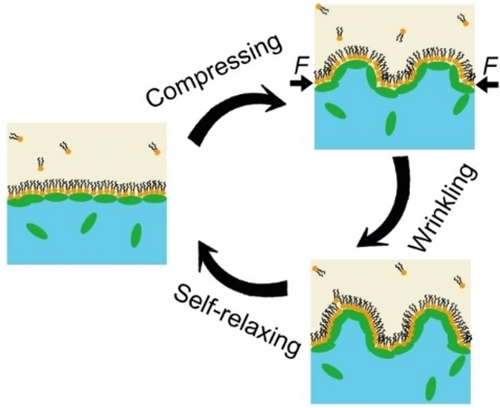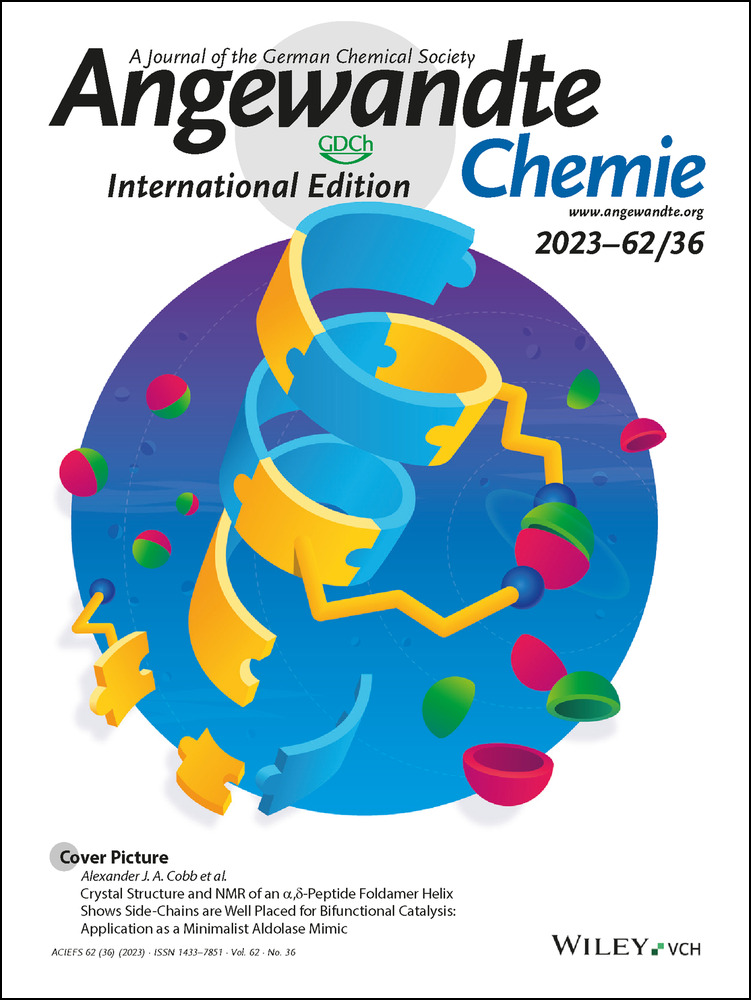Relaxing Wrinkles in Jammed Interfacial Assemblies
Corresponding Author
Ganhua Xie
State Key Laboratory for Chemo/Bio-Sensing and Chemometrics, College of Chemistry and Chemical Engineering, Hunan University, Changsha, 410082 China
Materials Sciences Division, Lawrence Berkeley National Laboratory, One Cyclotron Road, Berkeley, CA 94720 USA
These authors contributed equally to this work.
Search for more papers by this authorShipei Zhu
Materials Sciences Division, Lawrence Berkeley National Laboratory, One Cyclotron Road, Berkeley, CA 94720 USA
These authors contributed equally to this work.
Search for more papers by this authorPaul Y. Kim
Materials Sciences Division, Lawrence Berkeley National Laboratory, One Cyclotron Road, Berkeley, CA 94720 USA
Search for more papers by this authorShubao Jiang
State Key Laboratory for Chemo/Bio-Sensing and Chemometrics, College of Chemistry and Chemical Engineering, Hunan University, Changsha, 410082 China
Search for more papers by this authorQinpiao Yi
State Key Laboratory for Chemo/Bio-Sensing and Chemometrics, College of Chemistry and Chemical Engineering, Hunan University, Changsha, 410082 China
Search for more papers by this authorPei Li
Analytical Instrumentation Center, Hunan University, Changsha, 410082 China
Search for more papers by this authorZonglin Chu
State Key Laboratory for Chemo/Bio-Sensing and Chemometrics, College of Chemistry and Chemical Engineering, Hunan University, Changsha, 410082 China
Search for more papers by this authorBrett A. Helms
Materials Sciences Division, Lawrence Berkeley National Laboratory, One Cyclotron Road, Berkeley, CA 94720 USA
The Molecular Foundry, Lawrence Berkeley National Laboratory, One Cyclotron Road, Berkeley, CA 94720 USA
Search for more papers by this authorCorresponding Author
Thomas P. Russell
Materials Sciences Division, Lawrence Berkeley National Laboratory, One Cyclotron Road, Berkeley, CA 94720 USA
Polymer Science and Engineering Department, University of Massachusetts, Amherst, MA 01003 USA
Advanced Institute for Materials Research (AIMR), Tohoku University, 2-1-1 Katahira, Aoba, Sendai, 980-8577 Japan
Search for more papers by this authorCorresponding Author
Ganhua Xie
State Key Laboratory for Chemo/Bio-Sensing and Chemometrics, College of Chemistry and Chemical Engineering, Hunan University, Changsha, 410082 China
Materials Sciences Division, Lawrence Berkeley National Laboratory, One Cyclotron Road, Berkeley, CA 94720 USA
These authors contributed equally to this work.
Search for more papers by this authorShipei Zhu
Materials Sciences Division, Lawrence Berkeley National Laboratory, One Cyclotron Road, Berkeley, CA 94720 USA
These authors contributed equally to this work.
Search for more papers by this authorPaul Y. Kim
Materials Sciences Division, Lawrence Berkeley National Laboratory, One Cyclotron Road, Berkeley, CA 94720 USA
Search for more papers by this authorShubao Jiang
State Key Laboratory for Chemo/Bio-Sensing and Chemometrics, College of Chemistry and Chemical Engineering, Hunan University, Changsha, 410082 China
Search for more papers by this authorQinpiao Yi
State Key Laboratory for Chemo/Bio-Sensing and Chemometrics, College of Chemistry and Chemical Engineering, Hunan University, Changsha, 410082 China
Search for more papers by this authorPei Li
Analytical Instrumentation Center, Hunan University, Changsha, 410082 China
Search for more papers by this authorZonglin Chu
State Key Laboratory for Chemo/Bio-Sensing and Chemometrics, College of Chemistry and Chemical Engineering, Hunan University, Changsha, 410082 China
Search for more papers by this authorBrett A. Helms
Materials Sciences Division, Lawrence Berkeley National Laboratory, One Cyclotron Road, Berkeley, CA 94720 USA
The Molecular Foundry, Lawrence Berkeley National Laboratory, One Cyclotron Road, Berkeley, CA 94720 USA
Search for more papers by this authorCorresponding Author
Thomas P. Russell
Materials Sciences Division, Lawrence Berkeley National Laboratory, One Cyclotron Road, Berkeley, CA 94720 USA
Polymer Science and Engineering Department, University of Massachusetts, Amherst, MA 01003 USA
Advanced Institute for Materials Research (AIMR), Tohoku University, 2-1-1 Katahira, Aoba, Sendai, 980-8577 Japan
Search for more papers by this authorGraphical Abstract
Abstract
Dynamic covalent bonding has emerged as a mean by which stresses in a network can be relaxed. Here, the strength of the bonding of ligands to nanoparticles at the interface between two immiscible liquids affect the same results in jammed assemblies of nanoparticle surfactants. Beyond a critical degree of overcrowding induced by the compression of jammed interfacial assemblies, the bonding of ligands to nanoparticles (NPs) can be broken, resulting in a desorption of the NPs from the interface. This reduces the areal density of nanoparticle surfactants at the interface, allowing the assemblies to relax, not to a fluid state but rather another jammed state. The relaxation of the wrinkles caused by the compression reflects the tendency of these assemblies to eliminate areas of high curvature, favoring a more planar geometry. This enabled the generation of giant vesicular and multivesicular structures from these assemblies.
Conflict of interest
The authors declare no conflict of interest.
Open Research
Data Availability Statement
The data that support the findings of this study are available from the corresponding author upon reasonable request.
Supporting Information
As a service to our authors and readers, this journal provides supporting information supplied by the authors. Such materials are peer reviewed and may be re-organized for online delivery, but are not copy-edited or typeset. Technical support issues arising from supporting information (other than missing files) should be addressed to the authors.
| Filename | Description |
|---|---|
| anie202307713-sup-0001-misc_information.pdf2 MB | Supporting Information |
Please note: The publisher is not responsible for the content or functionality of any supporting information supplied by the authors. Any queries (other than missing content) should be directed to the corresponding author for the article.
References
- 1
- 1aL. Cipelletti, L. Ramos, J. Phys. Condens. Matter 2005, 17, R253;
- 1bL. Berthier, G. Biroli, J.-P. Bouchaud, L. Cipelletti, W. van Saarloos, Dynamical heterogeneities in glasses, colloids, and granular media, Vol. 150, OUP Oxford, 2011;
10.1093/acprof:oso/9780199691470.001.0001 Google Scholar
- 1cL. Berthier, J. Phys. Condens. Matter 2003, 15, S933.
- 2
- 2aW. Zou, J. Dong, Y. Luo, Q. Zhao, T. Xie, Adv. Mater. 2017, 29, 1606100;
- 2bT. Maeda, H. Otsuka, A. Takahara, Prog. Polym. Sci. 2009, 34, 581–604;
- 2cM. Capelot, M. M. Unterlass, F. Tournilhac, L. Leibler, ACS Macro Lett. 2012, 1, 789–792;
- 2dD. Montarnal, M. Capelot, F. Tournilhac, L. Leibler, Science 2011, 334, 965–968.
- 3
- 3aJ. Forth, P. Y. Kim, G. Xie, X. Liu, B. A. Helms, T. P. Russell, Adv. Mater. 2019, 31, 1806370;
- 3bP.-Y. Gu, F. Zhou, G. Xie, P. Y. Kim, Y. Chai, Q. Hu, S. Shi, Q.-F. Xu, F. Liu, J.-M. Lu, T. P. Russell, Angew. Chem. Int. Ed. 2021, 60, 8694–8699;
- 3cJ. Forth, A. Mariano, Y. Chai, A. Toor, J. Hasnain, Y. Jiang, W. Feng, X. Liu, P. L. Geissler, N. Menon, B. A. Helms, P. D. Ashby, T. P. Russell, Nano Lett. 2021, 21, 7116–7122;
- 3dM. Cui, T. Emrick, T. P. Russell, Science 2013, 342, 460–463.
- 4
- 4aA. Toor, J. Forth, S. Bochner de Araujo, M. C. Merola, Y. Jiang, X. Liu, Y. Chai, H. Hou, P. D. Ashby, G. G. Fuller, T. P. Russell, Langmuir 2019, 35, 13340–13350;
- 4bX. Liu, N. Kent, A. Ceballos, R. Streubel, Y. Jiang, Y. Chai, P. Y. Kim, J. Forth, F. Hellman, S. Shi, D. Wang, B. A. Helms, P. D. Ashby, P. Fischer, T. P. Russell, Science 2019, 365, 264–267.
- 5
- 5aY. Jiang, R. Chakroun, P. Gu, A. H. Gröschel, T. P. Russell, Angew. Chem. Int. Ed. 2020, 59, 12751–12755;
- 5bZ. Zhang, Y. Jiang, C. Huang, Y. Chai, E. Goldfine, F. Liu, W. Feng, J. Forth, T. E. Williams, P. D. Ashby, T. P. Russell, B. A. Helms, Sci. Adv. 2018, 4, eaap8045–8053.
- 6
- 6aZ. Li, Y. Shi, A. Zhu, Y. Zhao, H. Wang, B. P. Binks, J. Wang, Angew. Chem. Int. Ed. 2021, 60, 3928–3933;
- 6bB. P. Binks, A. T. Tyowua, Soft Matter 2016, 12, 876–887;
- 6cA. M. B. Rodriguez, B. P. Binks, Soft Matter 2020, 16, 10221–10243;
- 6dC. Huang, Z. Sun, M. Cui, F. Liu, B. A. Helms, T. P. Russell, Adv. Mater. 2016, 28, 6612–6618;
- 6eH. Sun, L. Li, T. P. Russell, S. Shi, J. Am. Chem. Soc. 2020, 142, 8591–8595.
- 7H. Sun, M. Li, L. Li, T. Liu, Y. Luo, T. P. Russell, S. Shi, J. Am. Chem. Soc. 2021, 143, 3719–3722.
- 8X. Wu, R. Streubel, X. Liu, Y. Kim Paul, Y. Chai, Q. Hu, D. Wang, P. Fischer, P. Russell Thomas, Proc. Natl. Acad. Sci. USA 2021, 118, e2017355118.
- 9
- 9aX. Wu, Q. Yuan, S. Liu, S. Shi, T. P. Russell, D. Wang, ACS Macro Lett. 2019, 8, 512–518;
- 9bK. Ito, M. Matsumoto, Nanomaterials 2022, 12, 1321;
- 9cC. Jiménez Saelices, M. Save, I. Capron, Polym. Chem. 2019, 10, 727–737.
- 10
- 10aA. A. Volkert, V. Subramaniam, M. R. Ivanov, A. M. Goodman, A. J. Haes, ACS Nano 2011, 5, 4570–4580;
- 10bY. Montelongo, D. Sikdar, Y. Ma, A. J. S. McIntosh, L. Velleman, A. R. Kucernak, J. B. Edel, A. A. Kornyshev, Nat. Mater. 2017, 16, 1127–1135.
- 11
- 11aT. Bhatia, P. Husen, J. Brewer, L. A. Bagatolli, P. L. Hansen, J. H. Ipsen, O. G. Mouritsen, Biochim. Biophys. Acta Biomembr. 2015, 1848, 3175–3180;
- 11bA. C. Greene, D. Y. Sasaki, G. D. Bachand, J. Visualization 2016, 111, e54051–54057.
- 12
- 12aC. Hoskins, J. Nanomed. Res. 2014, 1, 4–16;
10.15406/jnmr.2014.01.00004 Google Scholar
- 12bV. P. Torchilin, Nat. Rev. Drug Discovery 2005, 4, 145–160.
- 13
- 13aD. Pornpattananangkul, S. Olson, S. Aryal, M. Sartor, C.-M. Huang, K. Vecchio, L. Zhang, ACS Nano 2010, 4, 1935–1942;
- 13bJ. Liu, A. Stace-Naughton, C. J. Brinker, Chem. Commun. 2009, 5100–5102;
- 13cM. Li, R. L. Harbron, J. V. Weaver, B. P. Binks, S. Mann, Nat. Chem. 2013, 5, 529–536;
- 13dS. Mitragotri, D. G. Anderson, X. Chen, E. K. Chow, D. Ho, A. V. Kabanov, J. M. Karp, K. Kataoka, C. A. Mirkin, S. H. Petrosko, J. Shi, M. M. Stevens, S. Sun, S. Teoh, S. S. Venkatraman, Y. Xia, S. Wang, Z. Gu, C. Xu, ACS Nano 2015, 9, 6644–6654;
- 13eW. Wang, J. Luo, S. Wang, Adv. Healthcare Mater. 2018, 7, 1800484–1800511.





